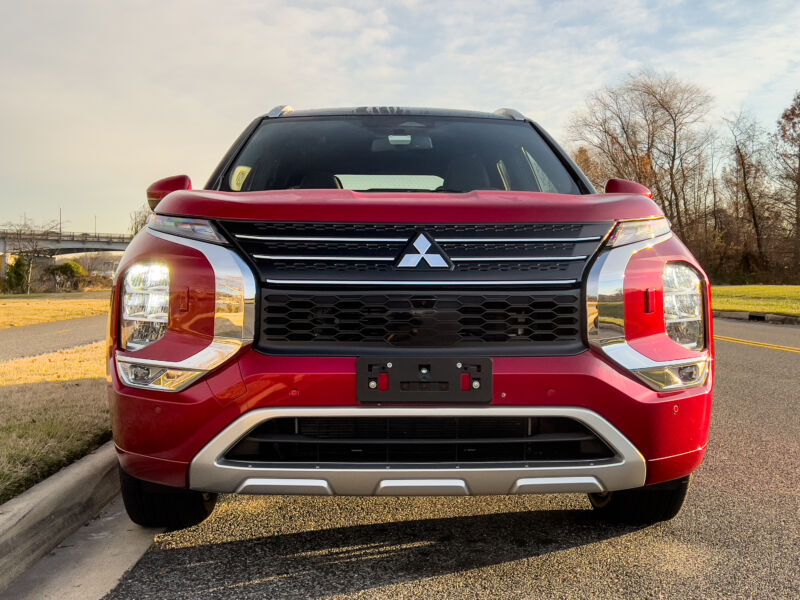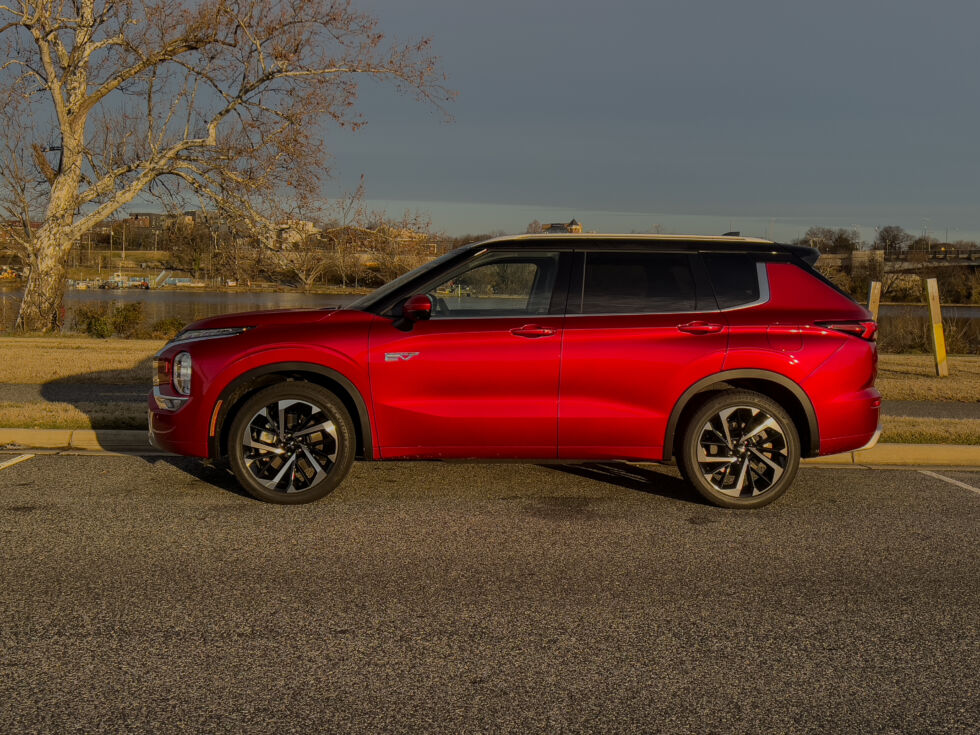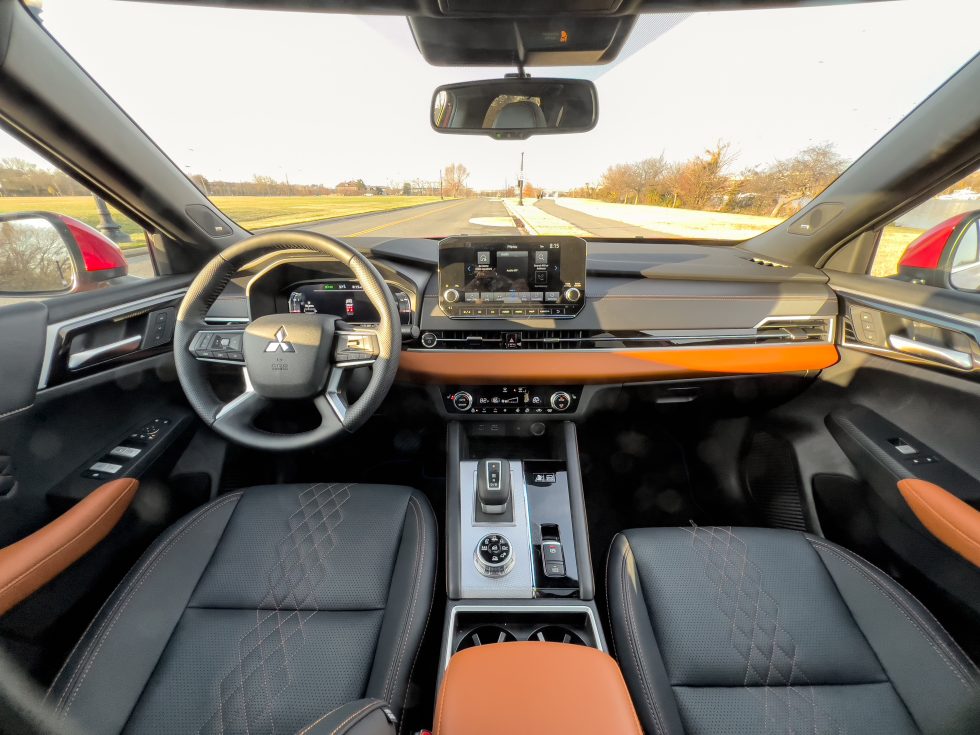Charge it every night and you may only ever run the engine on road trips.

What to make of Mitsubishi, now we’re almost a quarter of the way into this century? For enthusiasts of a certain age, the brand is synonymous with rallying and fire-breathing all-wheel drive sedans with extremely short service intervals. To my old driving instructor, Mitsubishi was the Mercedes of Japan. And a Mitsubishi was even the first electric vehicle I reviewed for Ars, way back in 2012.
These days it feels very much like the third brand at the Nissan-Renault alliance. The rallying heyday is long past, and its lineup here in the USA is down to just three SUVs and the sub-$20,000 Mirage, all focused on value for money rather than all-out luxury. Mitsubishi didn’t follow up the electric i-MiEV with another battery EV, but it does make a plug-in hybrid powertrain for the Outlander SUV.
The Outlander is relatively affordable by today’s standards, starting at $40,345, and a week with a model year 2024 example found it to be a solid PHEV with a big enough battery to make most of one’s daily motoring emission-free.

Going by sentiments from our audience, it’s possible to feel that the PHEV has almost been abandoned in favor of more on-trend battery EVs. And data from Consumer Reports isn’t particularly complimentary about PHEV reliability, although the same publication did find PHEVs (and BEVs) are cheaper to maintain than a car that just burns gasoline.
Ars actually tested the new Outlander PHEV—albeit briefly—just over a year ago. But a first-drive event held by an automaker is stage-managed in a way that just spending a week with a car isn’t, and I figured since I quite liked the last model, it wouldn’t be a wasted week.
They say it’s a compact
Mitsubishi classifies the Outlander PHEV as a compact SUV. One can quibble about whether an SUV that’s 185.4 inches (4,709 mm) long and 75 inches (1,905 mm) wide really is compact, but that starts to get into philosophical debates about technical definitions versus the commonly accepted meaning of words. The Outlander PHEV’s 106.5-inch (2,705 mm) wheelbase is sufficiently long to allow for a third row of seats in the back though, so it will seat seven humans, as long as the two in the back are pretty short.

Sitting in the driver’s seat there are no worries about being squished in, and both visibility and ergonomics throw up no horrible surprises. Button fans will be pleased to see there are plenty of them, controlling the climate as well as common infotainment functions, although you’ll interact with Apple CarPlay or Android Auto via the 9-inch touchscreen.
Under the hood lives a 2.4 L, four-cylinder gasoline engine that generates 131 hp (98 kW) and 144 lb-ft (195 Nm) under the Atkinson cycle, and it’s capable of sending that power to the front wheels, or to charge the 20 kWh lithium-ion battery.
Mostly the Outlander PHEV will only operate as a parallel hybrid when at highway cruising speed; at all other times it will operate as a series hybrid, with drive coming from the 113 hp (85 kW), 188 lb-ft (255 Nm) front electric motor and the 135 hp (100 kW), 144 lb-ft (195 Nm) rear electric motor. (The fact that PHEVs can be more efficient to operate as a parallel hybrid continues to make some series hybrid fans irrationally angry—if so, please let us know why in the comments.)
- Did I really average 39 mpg? Jonathan Gitlin
- If you want more conventional dials they’re just a button press away. Jonathan Gitlin
- Speaking of buttons, check out all the infotainment buttons. Jonathan Gitlin
On a fully charged battery—something that took about seven hours connected to a level 2 charger—the Outlander PHEV first reported 60 miles of electric range, but before too long the combination of winter temperatures and a more realistic assessment of my driving style saw this recalibrate frequently. The official EPA range is 38 miles, based on an average efficiency on battery power of just 1.9 miles/kWh (32.7 kWh/100 km).
In practice I actually saw 2.3 miles/kWh (27 kWh/100 km), and over more than 2,100 miles (3,400 km) the Outlander PHEV appears to have averaged an even more impressive 2.6 miles/kWh (23.9 kWh/100 km), so exceeding that EPA range estimate should be easily doable.Advertisement
Particularly if you press the button on the center console that turns on the one-pedal driving mode, called the “innovative pedal” in Mitsubishi-speak. (We should note that while there is a lot of lift-off regenerative braking in this mode, it won’t bring you to a complete stop and below about 3 mph (5 km/h) the Outlander PHEV will creep, like a conventional car with an automatic gearbox.
When you consider that study after study finds that most people don’t actually drive that many miles in a given day, it means that, as long as you charge it every night, the Outlander PHEV is probably capable of most daily motoring on battery power alone. And for those occasional road trips, you can either rely on the internal combustion engine, or avail yourself of a DC fast charger, assuming your Outlander PHEV is the $46,295 SEL version. However, the Mitsubishi is one of the remaining new vehicles to still use the CHAdeMO plug, which are now becoming few and far between.
- The view from behind Jonathan Gitlin
- There’s plenty of room in the middle row for large adults. Jonathan Gitlin
- Here, the third row of seats is stowed flat. Jonathan Gitlin
A rotary dial on the center console switches you through multiple different drive modes, which Mitsubishi says are an evolution of the Super All Wheel Control strategies it developed to good effect in the World Rally Championship and the Dakar Rally. Some of the modes are for slippery surfaces or off-road driving, and there’s a power mode should you need to tow anything. I spent almost the entire week in either normal or eco modes, and there’s also a tarmac setting that’s like a sport mode, although the Outlander PHEV never felt particularly sporty in day-to-day driving.
(During that week we actually got an invite from Mitsubishi to go drive the 2024 Outlander PHEV on an ice handling course in the frozen north of Canada to see just what the S-AWC system can do, but as much as I like driving sideways in the snow, we politely declined.)
Curiously, the Outlander PHEV also seemed to be a little more efficient over the course of our week than it did during last year’s first drive, or the official EPA rating of 26 mpg (9.05 L/100 km). But given how harsh the engine sounds when running versus the tranquility of operating on battery power, I suspect owners will try and charge regularly.




